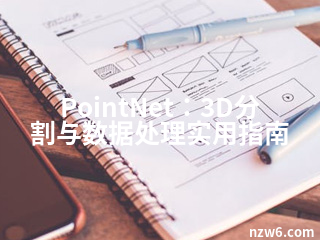PointNet:3D分割与数据处理实用指南
1. PointNet
PointNet是由斯坦福大学研究人员提出的开创性深度学习架构,专门用于处理3D点云数据。与传统方法不同,PointNet直接处理原始点云数据,无需将其转换为规则网格或体素。
核心特点:
- 置换不变性:对输入点的顺序不敏感
- 旋转不变性:通过变换网络实现
- 轻量高效:直接处理点云,减少计算开销
2. PointNet架构详解
2.1 主要组件
- 输入变换网络(T-net):学习一个3×3的变换矩阵,对齐输入点云
- 共享MLP:多层感知机处理每个点
- 特征变换网络:学习一个64×64的变换矩阵,对齐特征
- 池化层:提取全局特征
- 分类/分割网络:基于全局特征进行分类或分割
2.2 分割网络结构
输入点云(1024×3) → 输入变换 → 共享MLP(64,64,64,128,1024) →
池化 → 全局特征(1024) → 连接局部特征 →
共享MLP(512,256,128) → 输出分割结果
3. 数据处理流程
3.1 数据准备
import numpy as np
import h5py
def load_h5(h5_filename):
f = h5py.File(h5_filename)
data = f['data'][:]
label = f['label'][:]
return (data, label)
def load_data(data_dir, train_files, test_files):
train_data = []
train_labels = []
test_data = []
test_labels = []
for h5_filename in train_files:
data, label = load_h5(os.path.join(data_dir, h5_filename))
train_data.append(data)
train_labels.append(label)
for h5_filename in test_files:
data, label = load_h5(os.path.join(data_dir, h5_filename))
test_data.append(data)
test_labels.append(label)
train_data = np.concatenate(train_data, axis=0)
train_labels = np.concatenate(train_labels, axis=0)
test_data = np.concatenate(test_data, axis=0)
test_labels = np.concatenate(test_labels, axis=0)
return train_data, train_labels, test_data, test_labels
3.2 数据增强
def augment_point_cloud(batch_data):
""" 随机旋转和抖动点云数据 """
rotated_data = np.zeros(batch_data.shape, dtype=np.float32)
for k in range(batch_data.shape[0]):
# 随机旋转
rotation_angle = np.random.uniform() * 2 * np.pi
cosval = np.cos(rotation_angle)
sinval = np.sin(rotation_angle)
rotation_matrix = np.array([[cosval, 0, sinval],
[0, 1, 0],
[-sinval, 0, cosval]])
# 随机抖动
jittered_data = batch_data[k, ...] + np.random.normal(0, 0.02, size=batch_data[k, ...].shape)
rotated_data[k, ...] = np.dot(jittered_data.reshape((-1, 3)), rotation_matrix)
return rotated_data
4. 模型实现(PyTorch)
import torch
import torch.nn as nn
import torch.nn.functional as F
class TNet(nn.Module):
""" 变换网络 """
def __init__(self, k=3):
super(TNet, self).__init__()
self.k = k
self.conv1 = nn.Conv1d(k, 64, 1)
self.conv2 = nn.Conv1d(64, 128, 1)
self.conv3 = nn.Conv1d(128, 1024, 1)
self.fc1 = nn.Linear(1024, 512)
self.fc2 = nn.Linear(512, 256)
self.fc3 = nn.Linear(256, k*k)
self.bn1 = nn.BatchNorm1d(64)
self.bn2 = nn.BatchNorm1d(128)
self.bn3 = nn.BatchNorm1d(1024)
self.bn4 = nn.BatchNorm1d(512)
self.bn5 = nn.BatchNorm1d(256)
def forward(self, x):
batchsize = x.size()[0]
x = F.relu(self.bn1(self.conv1(x)))
x = F.relu(self.bn2(self.conv2(x)))
x = F.relu(self.bn3(self.conv3(x)))
x = torch.max(x, 2, keepdim=True)[0]
x = x.view(-1, 1024)
x = F.relu(self.bn4(self.fc1(x)))
x = F.relu(self.bn5(self.fc2(x)))
x = self.fc3(x)
iden = torch.eye(self.k, requires_grad=True).repeat(batchsize,1,1)
if x.is_cuda:
iden = iden.cuda()
x = x.view(-1, self.k, self.k) + iden
return x
class PointNetSeg(nn.Module):
""" PointNet分割网络 """
def __init__(self, num_classes):
super(PointNetSeg, self).__init__()
self.input_transform = TNet(k=3)
self.feature_transform = TNet(k=64)
self.conv1 = nn.Conv1d(3, 64, 1)
self.conv2 = nn.Conv1d(64, 64, 1)
self.conv3 = nn.Conv1d(64, 64, 1)
self.conv4 = nn.Conv1d(64, 128, 1)
self.conv5 = nn.Conv1d(128, 1024, 1)
self.bn1 = nn.BatchNorm1d(64)
self.bn2 = nn.BatchNorm1d(64)
self.bn3 = nn.BatchNorm1d(64)
self.bn4 = nn.BatchNorm1d(128)
self.bn5 = nn.BatchNorm1d(1024)
# 分割网络
self.conv6 = nn.Conv1d(1088, 512, 1)
self.conv7 = nn.Conv1d(512, 256, 1)
self.conv8 = nn.Conv1d(256, 128, 1)
self.conv9 = nn.Conv1d(128, num_classes, 1)
self.bn6 = nn.BatchNorm1d(512)
self.bn7 = nn.BatchNorm1d(256)
self.bn8 = nn.BatchNorm1d(128)
def forward(self, x):
num_points = x.size()[2]
# 输入变换
trans = self.input_transform(x)
x = x.transpose(2, 1)
x = torch.bmm(x, trans)
x = x.transpose(2, 1)
# 特征提取
x = F.relu(self.bn1(self.conv1(x)))
x = F.relu(self.bn2(self.conv2(x)))
# 特征变换
trans_feat = self.feature_transform(x)
x = x.transpose(2, 1)
x = torch.bmm(x, trans_feat)
x = x.transpose(2, 1)
pointfeat = x
x = F.relu(self.bn3(self.conv3(x)))
x = F.relu(self.bn4(self.conv4(x)))
x = F.relu(self.bn5(self.conv5(x)))
# 全局特征
global_feat = torch.max(x, 2, keepdim=True)[0]
global_feat = global_feat.view(-1, 1024, 1).repeat(1, 1, num_points)
# 分割网络
x = torch.cat([pointfeat, global_feat], 1)
x = F.relu(self.bn6(self.conv6(x)))
x = F.relu(self.bn7(self.conv7(x)))
x = F.relu(self.bn8(self.conv8(x)))
x = self.conv9(x)
x = x.transpose(2, 1).contiguous()
return x, trans, trans_feat
5. 训练技巧
5.1 损失函数
def pointnet_loss(outputs, labels, trans, trans_feat, alpha=0.001):
""" PointNet自定义损失函数 """
criterion = nn.CrossEntropyLoss()
loss = criterion(outputs, labels)
# 正则化变换矩阵
I = torch.eye(3).unsqueeze(0).repeat(trans.size(0), 1, 1)
if trans.is_cuda:
I = I.cuda()
loss += alpha * torch.mean(torch.norm(torch.bmm(trans, trans.transpose(2, 1)) - I, dim=(1,2)))
I = torch.eye(64).unsqueeze(0).repeat(trans_feat.size(0), 1, 1)
if trans_feat.is_cuda:
I = I.cuda()
loss += alpha * torch.mean(torch.norm(torch.bmm(trans_feat, trans_feat.transpose(2, 1)) - I, dim=(1,2)))
return loss
5.2 训练循环
def train(model, train_loader, optimizer, device):
model.train()
total_loss = 0
correct = 0
total = 0
for data, labels in train_loader:
data, labels = data.to(device), labels.to(device)
optimizer.zero_grad()
# 前向传播
outputs, trans, trans_feat = model(data)
outputs = outputs.view(-1, num_classes)
labels = labels.view(-1, 1)[:, 0]
# 计算损失
loss = pointnet_loss(outputs, labels, trans, trans_feat)
# 反向传播
loss.backward()
optimizer.step()
# 统计
total_loss += loss.item()
_, predicted = torch.max(outputs.data, 1)
total += labels.size(0)
correct += (predicted == labels).sum().item()
return total_loss / len(train_loader), correct / total
6. 应用案例
6.1 3D物体分割
# 加载预训练模型
model = PointNetSeg(num_classes=16).to(device)
model.load_state_dict(torch.load('pointnet_seg_model.pth'))
# 单点预测
def predict_single_pointcloud(pointcloud):
model.eval()
with torch.no_grad():
pointcloud = torch.from_numpy(pointcloud).float().unsqueeze(0).to(device)
outputs, _, _ = model(pointcloud)
pred = torch.argmax(outputs, dim=2)
return pred.squeeze().cpu().numpy()
# 可视化结果
def visualize_segmentation(points, seg_labels):
import matplotlib.pyplot as plt
from mpl_toolkits.mplot3d import Axes3D
fig = plt.figure(figsize=(10, 8))
ax = fig.add_subplot(111, projection='3d')
unique_labels = np.unique(seg_labels)
colors = plt.cm.get_cmap('tab20', len(unique_labels))
for i, label in enumerate(unique_labels):
mask = seg_labels == label
ax.scatter(points[mask, 0], points[mask, 1], points[mask, 2],
color=colors(i), label=f'Part {label}', s=10)
ax.legend()
plt.show()
7. 性能优化技巧
-
批处理优化:
- 确保所有点云样本具有相同点数(可通过采样或填充实现)
- 使用固定大小的点云输入(如1024点)
-
内存管理:
- 使用混合精度训练
scaler = torch.cuda.amp.GradScaler() with torch.cuda.amp.autocast(): outputs, trans, trans_feat = model(data) loss = pointnet_loss(outputs, labels, trans, trans_feat) scaler.scale(loss).backward() scaler.step(optimizer) scaler.update() -
推理加速:
- 使用TensorRT优化模型
- 对输入点云进行下采样减少计算量
8. 常见问题解决
-
训练不稳定:
- 降低学习率
- 增加批大小
- 检查变换矩阵的正则化权重
-
过拟合:
- 增加数据增强强度
- 添加Dropout层
- 使用更小的网络
-
分割边界不清晰:
- 增加局部特征的权重
- 使用CRF后处理
- 尝试PointNet++等更先进的架构
9. 扩展与进阶
- PointNet++:添加层次化特征学习,更好处理局部结构
- 动态图卷积:结合图神经网络处理点云
- 多任务学习:同时进行分类、分割和检测任务
- 实时应用:优化模型用于移动端或嵌入式设备
通过本指南,您应该已经掌握了PointNet在3D分割中的核心原理和实用实现方法。在实际应用中,根据具体任务需求调整网络结构和训练策略是关键。
(本文地址:https://www.nzw6.com/7019.html)







